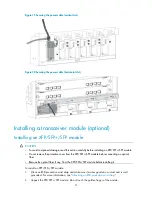
35
After powering on the switch, check the following items:
•
The cooling system is working, and you can hear fan rotating noise and feel air being blown out.
•
The system status LEDs on the MPUs show that the system is operating normally. For more
information about LED behaviors, see the chapter “
Appendix C LEDs
.”
Configuring the switch
By default, the switch does not authenticate the console login user at an AUX interface. To increase
system security and enable remote management:
•
Configure remote access services, for example, Telnet or SSH.
•
Configure authentication on each user interface, including the AUX interfaces.
Configuring authentication on a user interface
You can configure authentication on a user interface to control access to the switch.
Table 9
describes the Telnet login authentication methods available for a VTY user interface.
Table 9
Telnet login authentication methods
Authentication
method
Feature Application
scenarios
None
Easy to configure, allows any user to Telnet
to your switch, and lowest in security
Lab environments and extremely secure
network environments
Password
Easy to configure, secure, and flat user
management
Environments that do not need granular
privilege management
Username and
password
Complex to configure, secure, and
hierarchical user management
Environments where multiple operators
cooperate to manage the switch
NOTE:
For more information about login methods, see
HP A10500 Switch Series Fundamentals Configuration
Guide.
Configuring the basic access function
A switch without any configuration can perform basic data forwarding immediately after it is plugged
into a network. To implement more forwarding features, configure the basic network settings in
Table 10
on the switch.
Table 10
Basic network settings
Setting Description
IP address
Enables remote switch management, for example, by using Telnet.
Static routes
Implement static routing.
VLANs
Divide the LAN into multiple VLANs for data security.
MSTP
Avoids loops in a dual-homed network.

































